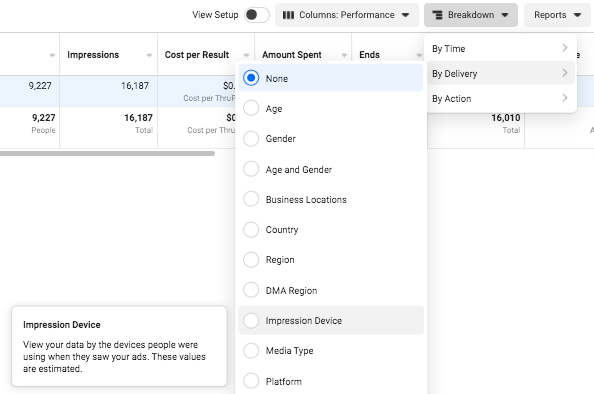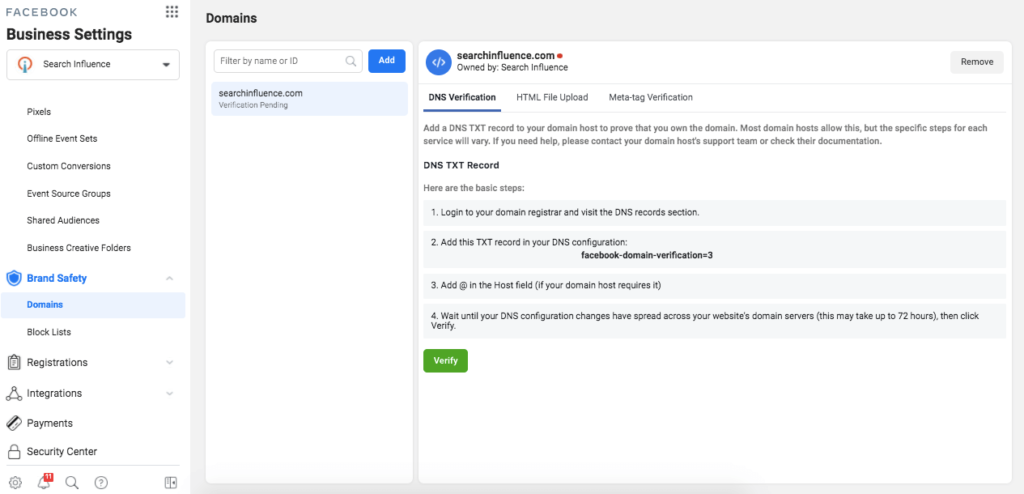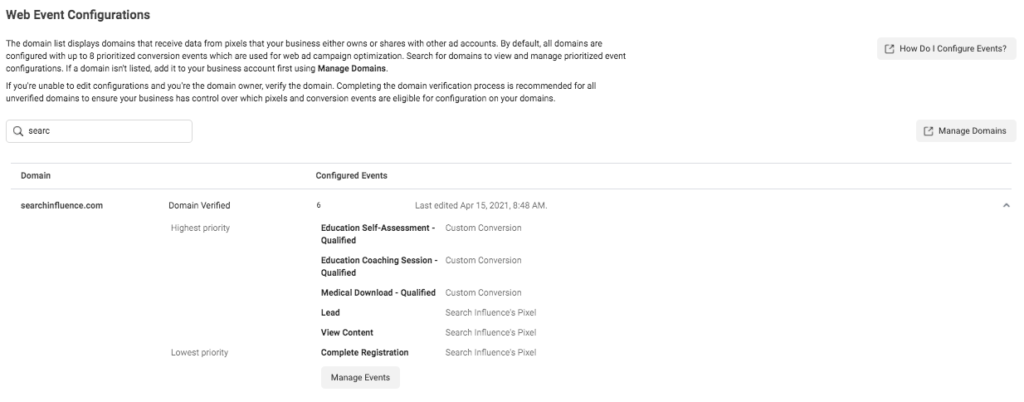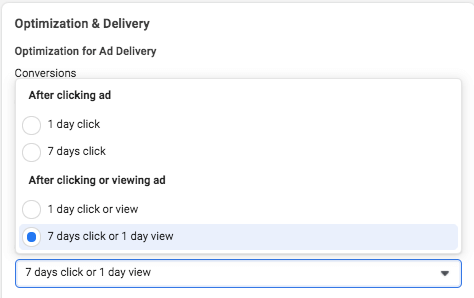Four Steps to Adapt to Apple iOS 14’s Impact on Your Facebook Ads
August 24th, 2021 by
This post was updated by Marissa Wehrer on August 24, 2021 to reflect updated news. It was originally published on January 20, 2021.
Key Insights
- Apple’s iOS 14.5 privacy update has had an industry-wide impact on businesses that use web conversion events to optimize, target, and report using Facebook’s business tools, such as the Facebook Pixel.
- The update will allow users to opt-out of having their activity tracked across other companies’ apps and websites.
- Take these four steps to adapt to this industry-altering change and run conversion campaigns in the future.
-
- Complete domain verification to configure pixel conversion events for Aggregated Event Measurement.
- Prioritize up to eight conversion events that are most important to your business.
- Understand how reporting changes will affect your ability to measure success and optimize your campaign.
- Identify new campaign strategies and best practices.
How Does the Apple iOS 14 Update Impact My Digital Ads?
On April 26, 2021, a significant update came to iOS 14 devices that asked users if they would like to “Allow Tracking” or “Ask Apps Not to Track” their activity across other companies’ apps and websites. The general consensus is that the majority of iOS 14 users will opt-out of tracking, thus preventing marketers from sending personalized advertising to those who opt-out.
Apple’s new policy has an industry-wide impact on personalized advertising.
This update will impact businesses that use web conversion events to optimize, target, and report using Facebook’s business tools, such as the Facebook Pixel. Effects include, but are not limited to, the inability to do the following:
- Target the right audience with the right message at the right time
- Allocate budget efficiently to produce the lowest cost per acquisition or return on ad spend
- Get the same amount of data and granularity of reporting to inform decision-making
Understand the scale that your campaign performance could be impacted by reviewing your ad account’s Impression Device delivery breakdown. This will help you analyze the percentage of your impressions served to Apple devices.
Despite these daunting changes, personalization is not at a total loss. Facebook Ads will remain an effective advertising channel if you rethink your current strategies and best practices.
If you plan to use Facebook Advertising as a lead driver and revenue generator, the following four steps will be vital to run conversion campaigns due to Apple’s upcoming AppTrackingTransparency framework for iOS 14.5 users.
Step 1: Complete domain verification to configure pixel conversion events for Aggregated Event Measurement.
Aggregated Event Measurement is a new Facebook tool that “processes pixel conversion events from iOS devices” in compliance with Apple’s new policy while ensuring advertisers can still run effective campaigns. This tool can only be accessed once your domain is verified.
As a new best practice for all businesses, you must complete domain verification. Domain verification is a way for you to claim ownership of your domain in Business Manager.
Following Facebook’s instruction, “Domain verification needs to be done at the effective top-level domain plus one (eTLD+1). For example, for www.books.jasper.co.uk, books.jasper.co.uk, and jasper.co.uk, the eTLD+1 domain is jasper.co.uk. This can help ensure that your domain verification will encompass all variations.” (Source)
Step 2: Prioritize the Eight Conversion Events That Are Most Important to Your Business.
Once domain verification is complete, you must use the Aggregated Event Measurement tool within Events Manager to set up the events that you want to track and their corresponding priorities. As a reminder, events allow Facebook’s machine learning to better target, optimize, and measure campaign performance.
With the Aggregated Event Measurement tool, Facebook is requiring you to define up to eight conversion events, whether standard events or custom conversions, per domain (this includes subdomains) and to put them in order of priority.
When it comes to prioritizing the events, you are going to put the most valuable action first and the least valuable action last. When a user completes multiple actions within a conversion window, only the highest priority event will be counted, and the conversions for the lower-prioritized events will not be counted.
If your campaigns are currently optimizing for over eight events across the same domain, make it a priority to strategize and select the eight events you will optimize for moving forward. If you are currently operating under the limit of eight events, then prioritizing your events is quite simple.
Follow Facebook’s documentation to configure Aggregated Event Measurement with your conversion events.
Once you have prioritized your events, adjust your conversion campaigns’ ad set optimization events accordingly. You’ll also need to ensure your conversion ads are attached to the proper domain at the ad level in the Tracking section.
Step 3: Understand how reporting changes will affect your ability to measure success and optimize your campaign.
There are new reporting limitations that you should note, as they may affect how you measure campaign success and optimize campaign performance.
Delayed reporting:
Data may be delayed up to 3 days, which could severely impact optimizing short-run campaigns. Another key difference is that conversions will now be reported at the time the conversion actually happened, instead of getting attributed to the last ad impression or click.
Estimated results:
Statistical modeling may be used to account for conversions from iOS 14 users.
No support for breakdowns:
Delivery and action breakdowns, such as age, gender, region, and placement will not be supported. This could greatly impact how you review and optimize campaign performance.
To test theories based on delivery and action, you will need to manually run tests, likely by creating more targeted ad sets. However, be mindful that this directly goes against Facebook’s best practice to use broad targeting to improve machine learning. (Source)
Changes to account attribution window settings:
First, the attribution window for all new or active ad campaigns is now set at the ad set level to ensure that the conversions measured are the same ones used to optimize ad delivery.
Additionally, the new default window is a seven-day click attribution window, and 28-day attribution will not be supported for new or active campaigns. The following windows will be supported under the new attribution setting:
- 1-day click
- 7-day click (default after Apple’s prompt enforcement in April)
- 1-day click and 1-day view
- 7-day click and 1-day view
As of January 2021, we saw a decrease in conversions due to the new attribution window settings set by Facebook.
Step 4: Identify new campaign strategies and best practices.
Optimizing: Test new optimization events
By being limited to only eight events, this may force you to determine new best practices on how to optimize your campaigns. If you previously optimized your campaign with low-funnel custom conversions, you may need to test broadening your optimization events to less-granular or higher-funnel actions to encompass more website touchpoints.
And if you haven’t switched to Campaign Budget Optimization (CBO) yet, then now may be a good time to let Facebook’s machine learning take some of the guesswork out of optimizing your campaign.
Targeting: Test new audiences and targeting
Our ability to target and remarket to your ideal customer with personalized ads will be severely limited. Mitigate the effects of the iOS update first by leveraging in-app products such as Facebook and Instagram Shops, lead gen forms, and using video. On-Facebook, engagement tends to be remarketable, which could replace some of the website data you’ll lose.
Take advantage of the most available data by using customer list custom audiences to build remarketing and lookalike audiences with website audiences using the pixel.
You may also want to consider removing the Audience Network as a placement from your ad sets because Facebook is not confident in its ability to deliver personalized ads for this placement to iOS 14 users.
Facebook stated, “Ultimately, despite our best efforts, Apple’s updates may render Audience Network so ineffective on iOS 14 that it may not make sense to offer it on iOS 14.” (Source)
Reporting: Test new key metrics
If you currently report using breakdowns by delivery or action, determine how or if you will continue reporting on this granular data moving forward. Since these reporting breakdowns are no longer available for conversion data, you may need to determine new key metrics to report on.
Navigating a New Digital Landscape
Apple’s iOS 14.5 privacy update is transforming the digital advertising landscape. Campaign performance may see its biggest impact around Q4, which is the six- to nine-month mark from the iOS 14.5 update. This is mostly because audience sources using website tracking will shrink even more since we can’t collect the same amount of data we once did. We’ll also see more adoption of the updated iOS as people upgrade their phones.
Stay on top of the upcoming changes and create new best practices for optimizing, targeting, and reporting to maintain control of your accounts.
It’s okay to feel a bit confused about the effects on your Facebook Ads because no one has all of the information or answers yet. If you have questions about how you can still generate leads for your business despite these changes, one of the experts at Search Influence can help. Contact us today to learn more.
Resources:
- User Privacy and Data Use
- How Apple’s iOS 14 Release May Affect Your Ads
- A checklist to prepare for iOS 14 changes for web events
- Preparing our partners for iOS 14: Mobile Web Advertising
- Preparing Our Partners for iOS 14
- Boost Liquidity and Work Smarter with Machine Learning
Images:





